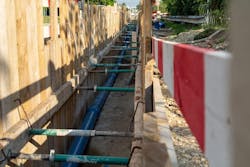COVID-19 Challenges & Investing in Infrastructure
About the author:
Megan Glover is CEO of 120Water, a digital water platform that protects public health by simplifying complex drinking water programs for government agencies and water systems. She can be reached at [email protected].
Water utilities have been under pressure for decades to modernize their infrastructure to keep pace with growth and to meet the maintenance needs of aging systems.
Considering that most drinking water pipes now are at least 70 years old, it’s not surprising that the U.S. EPA has estimated that the U.S. will need to invest $384 billion for drinking water infrastructure upgrades alone in the next 20 years.
That’s a hard number to swallow in good times. Now we have the added stress of dealing with COVID-19, which has diminished the ability of utilities to collect usage fees while stressing the budgets of municipalities. As a result, utilities are putting important infrastructure projects on the back burner.
This crisis reminds me a lot of where Flint County, Michigan, was five years ago. In an effort to reduce costs, the county made changes to its drinking water source, and we all know what happened after that.
Due to the pandemic, I fear the water industry may be forced to make near-term decisions due to lack of funding at the expense of future water safety.
The Legacy of COVID-19
The COVID-19 pandemic has impacted Americans in numerous ways. In addition to lives lost and the confusion about how to safely open up the economy again, households and businesses are hurting financially, and this has trickled down to utilities.
A study by the American Water Works Association (AWWA) shows drinking water utilities are taking a 17% revenue hit—a whopping $14 billion—because of the pandemic. This includes more than $5 billion in losses related to providing service disconnection grace periods, and increased payment delinquencies as a result of high unemployment rates. Add in reduced commercial water demand and it is easy to see how dire the situation is.
As a way to curb revenue losses, many utilities are planning future rate increases, and this makes sense. Sadly, they also are scaling back on water quality projects and delaying planned water infrastructure investments. The AWWA anticipates that the pandemic will cause water utilities across the nation to delay projects and reduce capital expenditures by as much as $5 billion. Certainly this will include delaying efforts to replace lead service lines, the leading cause of lead contaminated drinking water, which is especially harmful to young children and pregnant mothers.
To avoid another Flint-like crisis, the industry needs to figure out how to invest in innovation to drive down operational costs for running the utility while maximizing the funds available to them to continue to prioritize infrastructure programs innovative solutions for funding infrastructure needs despite skimpy funds. In other words, instead of thinking about ways to cut costs, we should be thinking about how we can innovate our way out of this challenge.
Commit to the Cause
Committing to the cause starts with agreeing that drinking water infrastructure programs are critical and must move forward if we are to provide a safe and sustainable water supply in the future. As the EPA has suggested, these infrastructure repair and replacement needs are massive. Even without the pandemic, utility revenues cannot cover the cost.
It also means that customers must understand that a safe water supply undergirds a robust economy. Most experts believe the economy will recover from COVID-19, so we must prepare today to meet future demands.
Leading with innovation will require utilities to take a new look at technologies that can drive efficiencies. Unfortunately, we already are behind other industries in the adoption of digital solutions.
I’ve written about Smart Water before and the role that digital technologies play in delivering a sustainable, healthy and affordable water supply to the customer. These technologies should play an even bigger role post-pandemic because of their ability to drive efficiencies and reduce the need for people-intensive resources.
The efficiencies and cost savings can be dramatic. For example, Pittsburgh Water & Sewer Authority (PWSA) adopted digital solutions to help manage its lead service line replacement program, saving 14,000 staff hours and reducing the cost of tap water sample kits by 80%. Customer service also skyrocketed, with tap test results coming in 88% faster and customer notification of results in just 24 hours.
Tap Government and Alternative Funding Sources
Digital solutions may save resources and drive efficiencies, yet utilities will still need to find funding to complete needed projects. In order to do this, we must keep up the pressure on Congress to make infrastructure investment a priority, while also looking for alternative funding sources outside of the government for capital infrastructure needs.
Since a sustainable and healthy drinking water supply is needed for a competitive economy, Congress could and should make infrastructure programs part of pandemic economic recovery strategies. The American Society of Civil Engineers (ASCE) smartly is urging Congress to provide federal drinking water and wastewater assistance for ratepayers, while also delivering federal economic relief to water utilities to offset revenue losses from the pandemic.
Investing in water infrastructure will have the added benefit of creating high-wage jobs that are needed to help the economy spring back from the pandemic.
Apart from government assistance, public-private partnership (PPP) agreements can play an important role in modernizing drinking water infrastructure. These partnerships between government and private entities provide the funds needed to design, build, and finance new infrastructure without the steep rate hikes that would be necessary with some government-funded programs.
In addition to providing private sector capital, these partnerships can speed projects and bring expanded expertise to projects, while reducing risk to communities. A number of cities, including Atlanta, Phoenix and Seattle, have already successfully launched PPP projects to rebuild aging infrastructure.
The sudden and deep fall off in revenue in the face of important challenges has shocked many utilities looking at a long list of important infrastructure projects. If there can be one bright spot in the pandemic, I hope it will be this: it may prompt utilities and governments to rethink how infrastructure programs are financed and managed going forward.
There is a saying that is appropriate for these times: “When the lawn needs mowing, you have to mow the lawn.” In other words, some things in life demand attention whether or not it is convenient. The challenges the water industry is facing today demand our attention now. They will not diminish or go dormant if they are put off. They will continue to grow in urgency until we are forced to take care of them.

